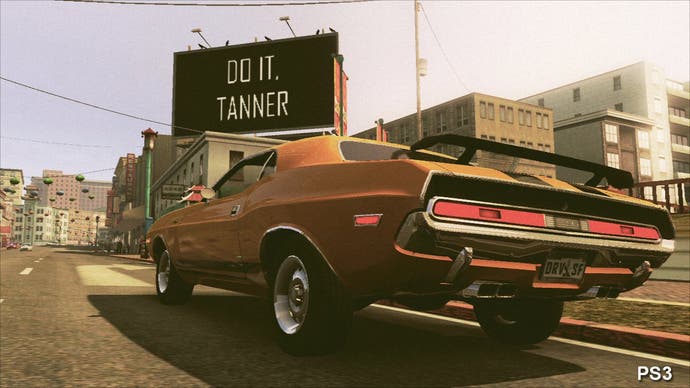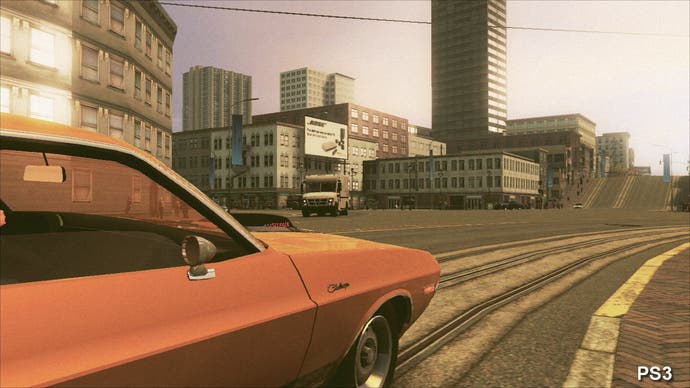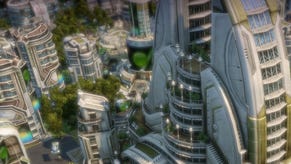Face-Off: Driver: San Francisco
Shift happens.
| - | Xbox 360 | PlayStation 3 |
|---|---|---|
| Disc Size | 6.4GB | 9.0GB |
| Install | 6.4GB (optional) | 1231MB (mandatory) |
| Surround Support | Dolby Digital | Dolby Digital, DTS, 5.1LPCM |
Driver: San Francisco is a game we should treasure - a technological showcase built around an original game design that seeks to blend the traditional open world driving game with what you might describe as an action RTS, blended via riffs clearly inspired by the BBC's Life on Mars. It sounds insane, but it works really well, feeling fresh and unique in a market where surprises are few and far between.
The core game mechanic that sets this new Driver apart from its competition is known as "Shift". Series veteran Tanner is trapped in a coma, which gives him superhuman-like powers within what we assume is his own imagination. He can "shift" between vehicles at will and use them as he sees fit to complete the various missions on offer. Cop buddies having trouble catching a joyrider? Simply shift between the cops and ram the offender off the road... and if he's still proving elusive, shift into oncoming traffic and plough head-on into the perp. It's all very reminiscent of the way that the agents could switch from body to body in The Matrix.
The further you progress into story mode, the more powerful Shift becomes, to the point where Tanner has an almost god-like overview of the entire city. It's a great idea that is beautifully handled in-game, and the technological achievement in making this work seamlessly is substantial - but more on that later. In the meanwhile, let's get to grips with the quality of each console version, with the head-to-head movie kicking off proceedings backed as ever by an extensive comparison gallery.
There have been some interesting comments about the image quality of the Xbox 360 and PlayStation 3 games, with the general impression being that the Microsoft platform possesses a more refined output. We reckon that both games are running at just under 720p - 1120x720, or thereabouts, but there do appear to be some differences in the way anti-aliasing is handled.
Looking at still comparisons, the edge smoothing appears to be operating with more samples on the Xbox 360. At times we see anti-aliasing that looks very much like 4x multi-sample AA on the Xbox 360, while the PlayStation 3 runs with a 2x MSAA equivalent. However, with the game in motion, we see a lot of pixel crawl suggesting that both versions are using a form of post-process anti-aliasing, which would make much more sense bearing in mind the fact that Driver: San Francisco is looking to render an entire frame in just 16ms in order to reach its target 60FPS frame rate. An older version of FXAA is a likely candidate.
Another area where we see differences here is in how the overhead cables are being displayed: typically these are very well anti-aliased on Xbox 360, but the implementation can look much rougher on the PlayStation 3.




Other differences in image quality come down to the difference in gamma balance and the sense that lighting appears to be subtly different between the two platforms; in places it seems that more detail is "bleached out" on PS3 due to a harsher effect. Aside from a few other minor issues, the games are otherwise equal, but it's the 60FPS target that perhaps deserves the most scrutiny.
Driver: San Francisco is probably the first open world driving game to target 60 frames per second since Criterion's much-loved Burnout Paradise. There's a definite emphasis in console game development to go for 30FPS and reap the benefits of the additional processing time in creating more detailed, richer visuals. Reflections appears to have shared the same philosophy as Criterion Games - the lower the latency in the controls and the smoother the visual feedback, the better the driving experience.
Reflections' title doesn't have quite the same level of visual refinement and style as Burnout Paradise, and the lighting doesn't seem to be quite as sophisticated (there's no time of day in Driver as there is in Paradise City) but it's clear that the environments are more densely populated, there's much more in the way of traffic being rendered - plus there's the inclusion of pedestrians too, though it's mostly of an ornamental nature.
Compared to the standard 30FPS racers out there, there's clearly a detail deficit in terms of the cars, shadow detail is low making people and vehicles stick out somewhat, while lighting is unsophisticated compared to the deferred rendering set-ups we've seen in the likes of Blur and Shift 2: Unleashed. The compromise pays off though. Driver: San Francisco's vehicle simulation model just feels wonderful to play with: response is tight and the drifting mechanic feels highly intuitive.
The question is, how well do the console versions manage to sustain that all-important frame rate? Players of the demo on both Xbox 360 and PlayStation 3 will know that the game disengages v-sync when the engine is under stress, resulting in GT5-style screen-tear. How does this affect gameplay and image quality and does one version pull ahead of the other?
We've got three tests to show you. In the first one above we've strung together a range of engine-driven cut-scenes. This gives us a chance to look at the game's performance in what we would hope would be as close to like-for-like circumstances as possible.















